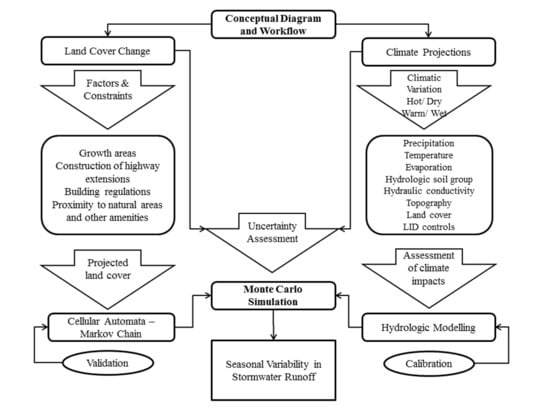Coupling Land Use Change Modeling with Climate Projections to Estimate Seasonal Variability in Runoff from an Urbanizing Catchment Near Cincinnati, Ohio
Abstract
:1. Introduction
2. Materials and Methods
2.1. Description of the Study Area
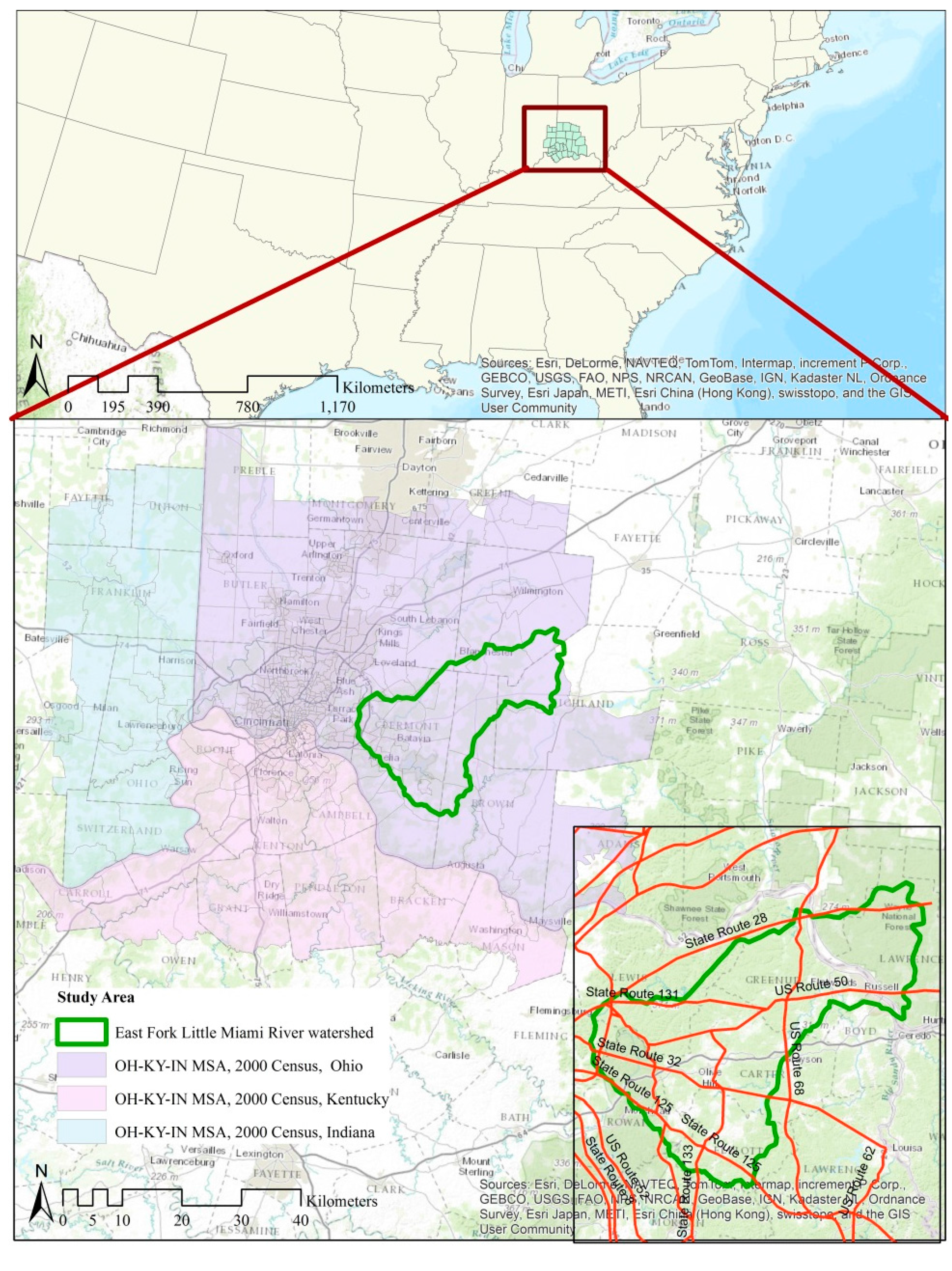
2.2. Conceptual Framework
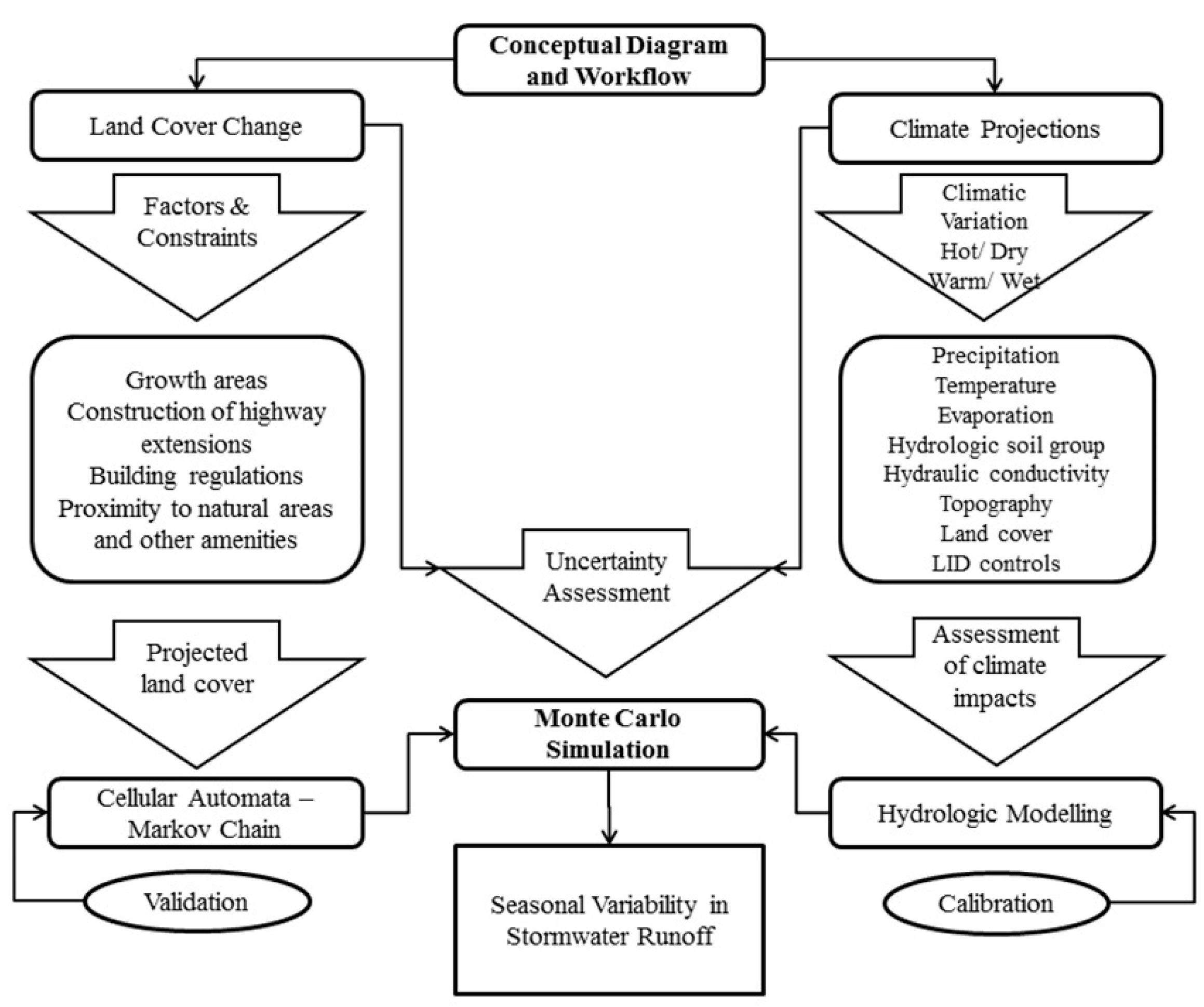
2.3. CA-MARKOV Model of Land Cover Change
2.4. Assessment of the Impact of Climate Variability on Hydrologic Endpoints
| Month | Hydrologic Endpoint Values Based on Historical Record 1969–2004 | ||||
|---|---|---|---|---|---|
| 100-Year Flood (m3 s−1) | 7Q10 (m3 s−1) | Maximum (m3 s−1) | Mean (m3 s−1) | Minimum (m3 s−1) | |
| January | 49.4 | 8.9 | 95.6 | 18.1 | 0.3 |
| February | 88.8 | 10.4 | 59.6 | 18.1 | 1.1 |
| March | 50.2 | 9.8 | 38.6 | 17.1 | 5.3 |
| April | 105.7 | 8.2 | 60.0 | 19.2 | 7.4 |
| May | 366.3 | 8.8 | 134.0 | 23.7 | 8.0 |
| June | 351.6 | 9.8 | 131.3 | 25.0 | 7.4 |
| July | 189.1 | 9.9 | 90.4 | 19.3 | 6.9 |
| August | 42.8 | 6.0 | 90.5 | 17.1 | 5.4 |
| September | 79.0 | 4.4 | 46.0 | 14.3 | 4.0 |
| October | 64.1 | 4.9 | 38.4 | 14.2 | 4.3 |
| November | 50.0 | 4.1 | 38.3 | 13.2 | 4.0 |
| December | 60.3 | 3.9 | 40.9 | 15.4 | 3.8 |
| Scenarios/ | Deltas from General Circulation Models Output for 2010–2039 | ||||||
|---|---|---|---|---|---|---|---|
| Timeseries | CCCM a | CCSR b | CSIR c | ECHM d | HDCM e | NCAR f | GDFL g |
| A2 (mid-high) | Projected percent change in average precipitation over the base period 1971–2000 | ||||||
| Annual | 0.04 | −0.03 | −0.02 | −0.02 | 0.03 | 0.04 | 0.02 |
| Winter | 0.00 | 0.08 | 0.05 | −0.14 | 0.06 | 0.11 | −0.01 |
| Spring | 0.08 | −0.01 | 0.04 | −0.05 | 0.05 | −0.01 | 0.02 |
| Summer | −0.02 | −0.14 | 0.01 | 0.06 | 0.05 | 0.01 | 0.00 |
| Fall | 0.16 | 0.03 | −0.20 | 0.00 | −0.19 | 0.21 | 0.14 |
| B2 (mid-low) | Projected percent change in average precipitation over the base period 1971–2000 | ||||||
| Annual | 0.08 | 0.07 | 0.04 | 0.06 | 0.03 | −0.01 | 0.01 |
| Winter | −0.02 | 0.08 | 0.08 | 0.01 | 0.05 | 0.05 | −0.01 |
| Spring | 0.06 | 0.05 | 0.00 | −0.01 | 0.02 | −0.03 | 0.02 |
| Summer | 0.03 | 0.03 | 0.09 | 0.09 | 0.10 | −0.05 | −0.03 |
| Fall | 0.33 | 0.12 | −0.02 | 0.13 | −0.09 | 0.07 | 0.12 |
2.5. Sensitivity Testing
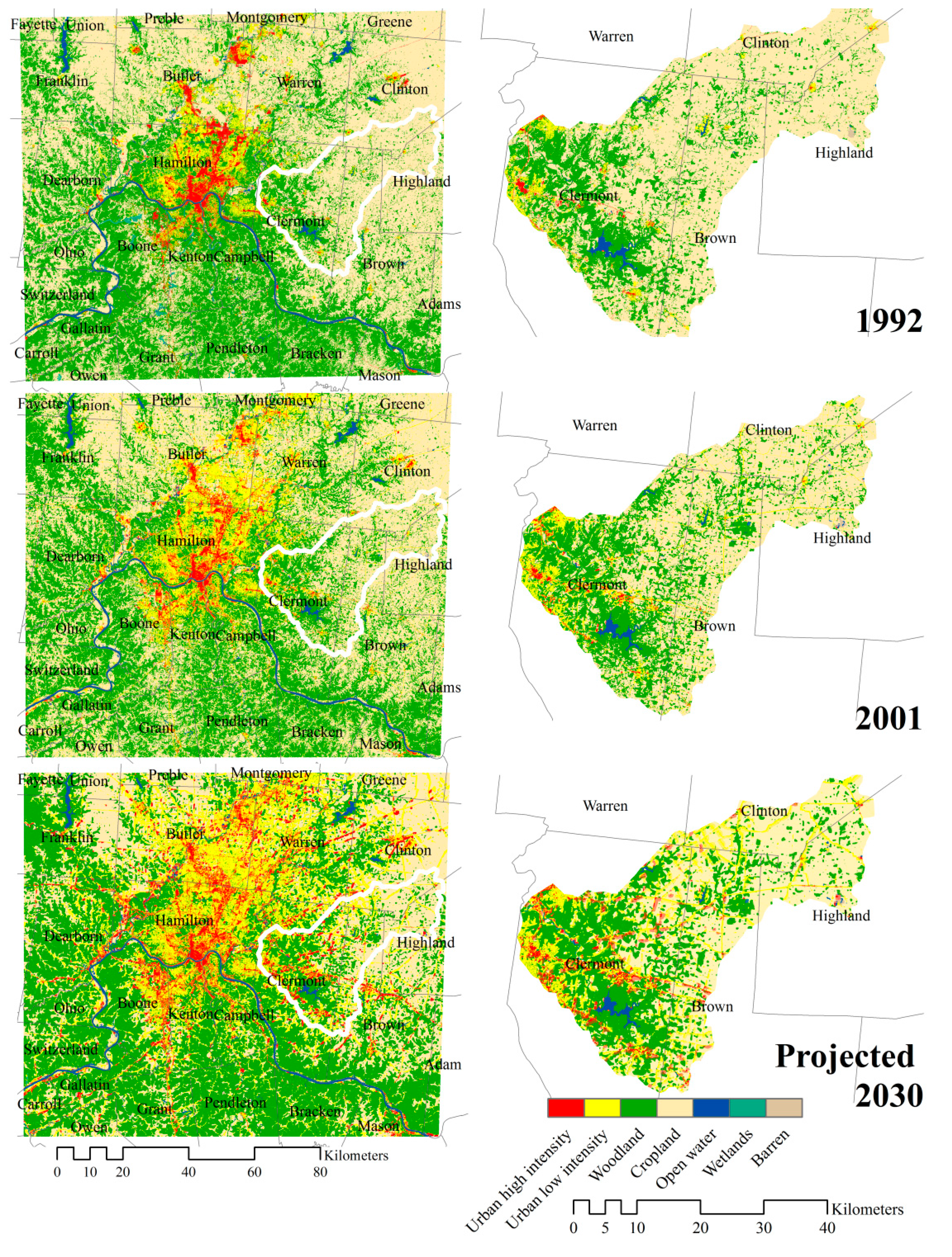
3. Results and Discussion
3.1. Land Cover Change
| OH-KY-IN MSA | 1992 | 2001 | Projected 2010 | Projected 2020 | Projected 2030 |
|---|---|---|---|---|---|
| Urban High Intensity | 361.38 | 377.71 | 538.97 | 700.70 | 860.72 |
| Urban Low Intensity | 662.94 | 1831.12 | 2335.50 | 2706.92 | 3029.08 |
| Woodland/Open space | 5440.65 | 5519.76 | 5942.51 | 6038.76 | 6098.52 |
| Cropland | 7360.33 | 6138.60 | 5061.85 | 4429.27 | 3884.77 |
| Water | 234.83 | 242.27 | 247.31 | 250.70 | 253.38 |
| Wetlands | 71.43 | 25.97 | 27.29 | 28.17 | 29.10 |
| Barren land | 18.10 | 14.22 | 12.95 | 11.88 | 10.92 |
| EFLMR Watershed | 1992 | 2001 | 2010 | 2020 | 2030 |
| Urban High Intensity | 10.35 | 14.74 | 29.19 | 29.21 | 85.37 |
| Urban Low Intensity | 39.80 | 117.48 | 135.45 | 169.48 | 263.89 |
| Woodland/ Open space | 328.17 | 417.42 | 420.31 | 420.38 | 397.01 |
| Cropland | 885.59 | 713.77 | 678.21 | 644.09 | 517.37 |
| Water | 12.79 | 12.80 | 12.75 | 12.75 | 13.00 |
| Wetlands | 2.34 | 2.03 | 2.44 | 2.44 | 2.52 |
| Barren land | 1.30 | 2.10 | 1.99 | 1.99 | 1.18 |
3.2. Incorporating Downscaled Climate Projections in BASINS-HSPF
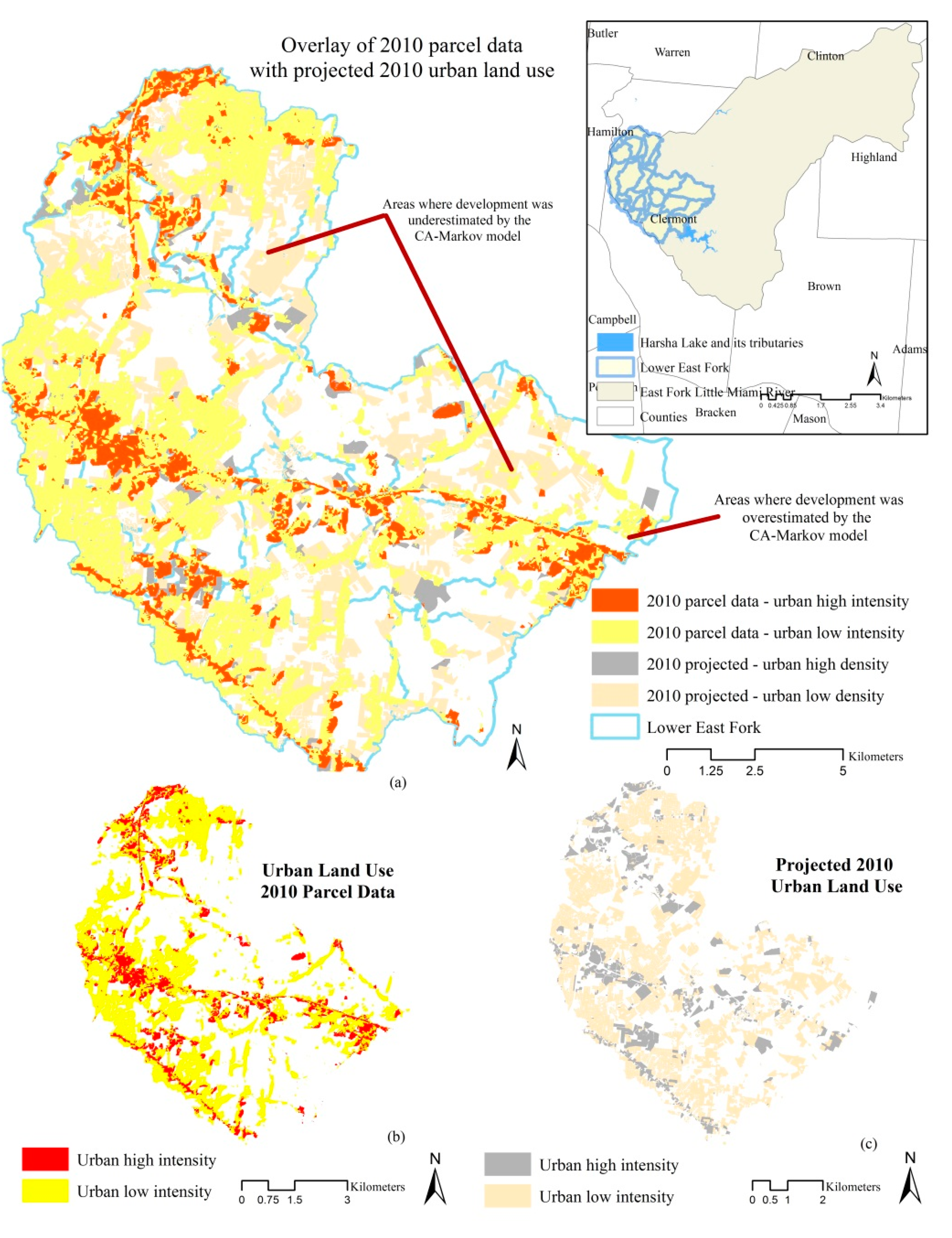
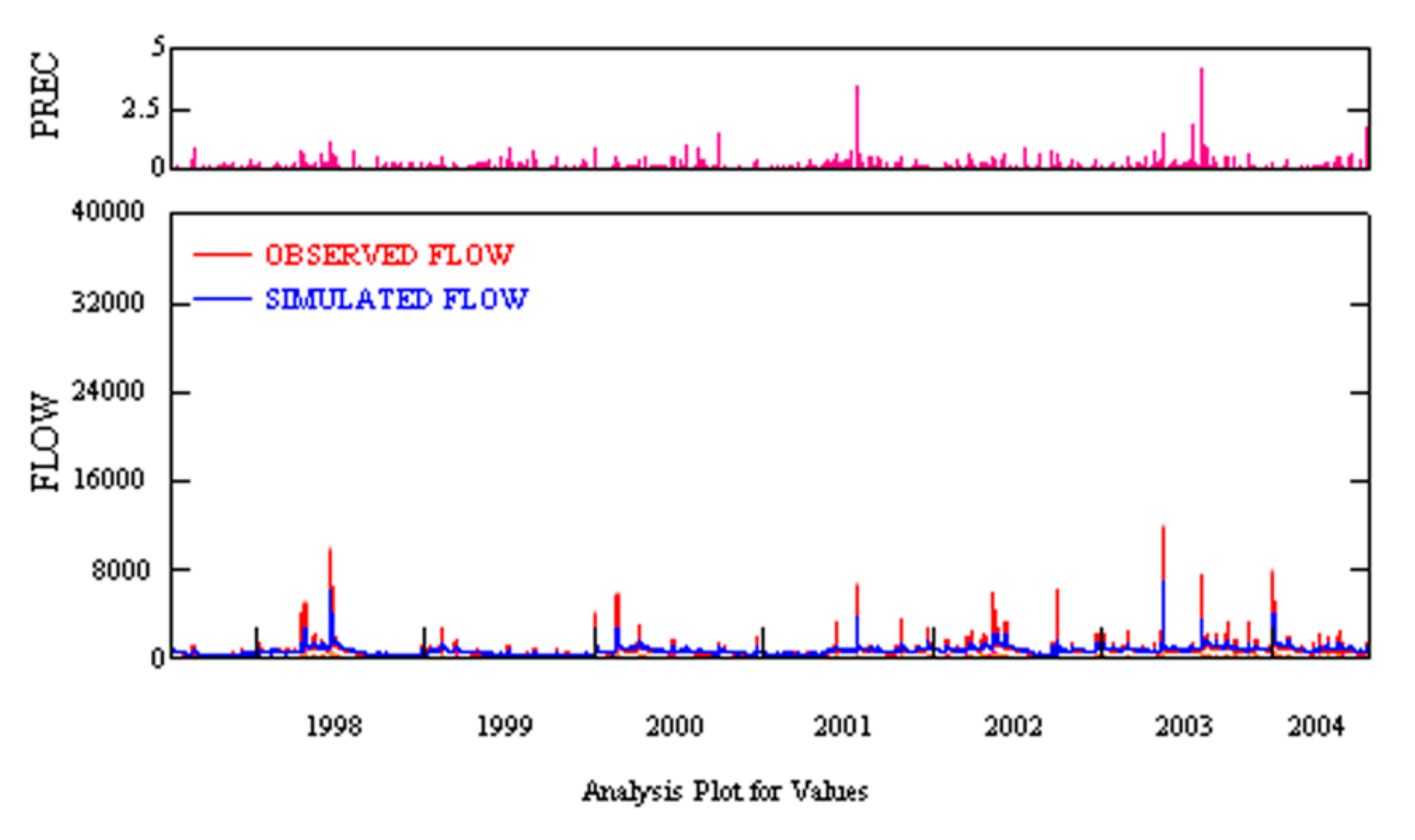
3.3. Monte Carlo Simulation
| Emissions Scenario | 100-Year Flood | 7Q10 | Mean | ||||
|---|---|---|---|---|---|---|---|
| Baseline (X) | (m3 s-1) | (m3 s-1) | (m3 s-1) | ||||
| Winter | 66.2 | 7.7 | 17.2 | ||||
| Spring | 174.1 | 8.9 | 20.0 | ||||
| Summer | 194.5 | 8.6 | 20.4 | ||||
| Fall | 64.4 | 4.5 | 13.9 | ||||
| Mid-High (A2) IPCC Emissions Scenario: X1 | Probability of Exceeding Baseline Values | ||||||
| Projected Change in Precipitation | P(X>X1) | P(X<X1) | P(X>X1) | ||||
| Min (ECHM) | −0.14 | Max (NCAR) | 0.11 | Winter | 0.123 | 0.029 | 0.077 |
| Min (ECHM) | −0.05 | Max (CCCM) | 0.08 | Spring | 0.045 | 0.013 | 0.022 |
| Min (CCSR) | −0.14 | Max (ECHM) | 0.06 | Summer | 0.036 | 0.035 | 0.010 |
| Min (CSIR) | −0.20 | Max (NCAR) | 0.21 | Fall | 0.177 | 0.009 | 0.085 |
| Mid-Low (B2) IPCC Emissions Scenario: X2 | Probability of Exceeding Baseline Values | ||||||
| Projected Change in Precipitation | P(X>X2) | P(X<X2) | P(X>X2) | ||||
| Min (CCCM) | −0.01 | Max (CSIR, CCSR) | 0.08 | Winter | 0.097 | 0.016 | 0.026 |
| Min (NCAR) | −0.03 | Max (CCCM) | 0.06 | Spring | 0.032 | 0.042 | 0.014 |
| Min (NCAR) | −0.05 | Max (HDCM) | 0.10 | Summer | 0.021 | 0.044 | 0.028 |
| Min (HDCM) | −0.09 | Max (CCCM) | 0.33 | Fall | 0.254 | 0.015 | 0.109 |
3.4. Sensitivity Analysis
| Climate Change Scenario | Hot/Dry/Near Term | Warm Wet/Near Term | ||||||||
|---|---|---|---|---|---|---|---|---|---|---|
| Percent Impervious | 31.20% | 53.20% | 53.20% | 90.00% | 90.00% | 31.20% | 53.20% | 53.20% | 90.00% | 90.00% |
| Wet Day Threshold (Inches) | 0.1 | 0.1 | 0.1 | 0.1 | 0.1 | 0.1 | 0.1 | 0.1 | 0.1 | 0.1 |
| LID control: | % of impervious area treated/% of treated area used for LID | |||||||||
| Disconnection | 10 | 10 | 10 | 0 | 10 | 10 | 10 | 10 | 0 | 10 |
| Rain harvesting | 0 | 0 | 2 | 0 | 0 | 0 | 0 | 2 | 0 | 0 |
| Rain gardens | 0 | 0 | 5 | 0 | 0 | 0 | 0 | 5 | 0 | 0 |
| Street planters | 10 | 10 | 10 | 0 | 10 | 10 | 10 | 10 | 0 | 10 |
| Infiltration basins | 0 | 0 | 10 | 0 | 0 | 0 | 0 | 10 | 0 | 0 |
| Porous pavement | 5 | 5 | 5 | 0 | 5 | 5 | 5 | 5 | 0 | 5 |
| Results: | Scenario 1 | Scenario 2 | Scenario 3 | Scenario 4 | Scenario 5 | Scenario 6 | Scenario 7 | Scenario 8 | Scenario 9 | Scenario 10 |
| Average Annual Rainfall (in) | 45.8 | 42.48 | 42.48 | 42.48 | 42.48 | 46.92 | 46.92 | 46.92 | 46.92 | 46.92 |
| Average Annual Runoff (in) | 18.27 | 19.1 | 13.06 | 32.89 | 27.1 | 15.97 | 15.1 | 15.01 | 36.96 | 30.82 |
| Days per Year With Rainfall | 82.34 | 80.79 | 80.84 | 80.79 | 80.79 | 85.00 | 80.79 | 84.94 | 84.99 | 84.99 |
| Days per Year with Runoff | 51.46 | 47.37 | 39.32 | 64.76 | 59.51 | 46.57 | 46.72 | 43.42 | 68.7 | 62.61 |
| Percent of Wet Days Retained | 37.5 | 41.37 | 51.36 | 19.85 | 26.35 | 45.21 | 42.18 | 48.88 | 19.17 | 26.34 |
| Smallest Rainfall w/Runoff (in) | 0.19 | 0.16 | 0.23 | 0.10 | 0.11 | 0.19 | 0.23 | 0.19 | 0.11 | 0.12 |
| Largest Rainfall w/o Runoff (in) | 0.35 | 0.36 | 0.43 | 0.21 | 0.28 | 0.39 | 0.36 | 0.41 | 0.23 | 0.25 |
| Max. Rainfall Retained (in) | 1.94 | 1.00 | 2.02 | 0.55 | 0.79 | 2.00 | 1.95 | 2.11 | 0.62 | 0.87 |
| Infiltration (%) | 52 | 57 | 61 | 9 | 21 | 34 | 35 | 61 | 9 | 21 |
| Evaporation (%) | 8 | 8 | 7 | 14 | 15 | 8 | 8 | 7 | 13 | 14 |
| Runoff (%) | 40 | 35 | 32 | 77 | 63 | 58 | 57 | 32 | 78 | 65 |
4. Conclusions
Acknowledgments
Author Contributions
Conflicts of Interest
References
- Kunkel, K.; Pielke, R.A., Jr.; Changnon, S.A. Temporal fluctuations in weather and climate extremes that cause economic and human health impacts: A review. Bull. Am. Meteorol. Soc. 1999, 80, 1077–1098. [Google Scholar]
- Pielke, R.A., Jr.; Downton, M.W. Precipitation and damaging floods: Trends in the United States, 1932–1997. J. Clim. 2000, 13, 3625–3637. [Google Scholar]
- Pielke, R.A., Jr. Statement of Dr. Roger Pielke Jr. to the Committee on Environment and Public Works of the United States Senate. Available online: http://epw.senate.gov/107th/Pielke_031302.htm#_edn1 (accessed on 13 March 2002).
- Brody, S.D.; Zahran, S.; Maghelal, P.; Grover, H.; Highfield, W.E. The rising cost of floods: Examining the impact of planning and development decisions on property damage in Florida. J. Am. Plan. Assoc. 2007, 73, 330–345. [Google Scholar] [CrossRef]
- Pielke, R.A., Jr.; Gratz, J.; Landsea, C.W.; Collins, D.; Saunders, M.; Musulin, R. Normalized hurricane damages in the United States: 1900–2005. Nat. Hazards Rev. 2008, 9, 29–42. [Google Scholar] [CrossRef]
- National Oceanic and Atmospheric Administration (NOAA). Billion Dollar U.S. Weather/Climate Disasters; National Climatic Data Center: Asheville, NC, USA, 2011. [Google Scholar]
- BASINS 4.0 Climate Assessment Tool (CAT): Supporting Documentation and User’s Manual; EPA/600/R-08/088F; U.S. Environmental Protection Agency: Washington, DC, USA, 2009.
- Manabe, S.; Milly, P.C.D.; Wetherald, R.T. Simulated long-term changes in river discharge and soil moisture due to global warming. Hydrol. Sci. J. 2004, 49, 625–642. [Google Scholar] [CrossRef]
- Denault, C.; Millar, R.G.; Lence, B.J. Assessment of possible impacts of climate change in an urban catchment. J. Am. Water Resour. Assoc. 2006, 42, 685–697. [Google Scholar] [CrossRef]
- Arnell, N.W.; Reynard, N.S. The effects of climate change due to global warming on river flows in Great Britain. J. Hydrol. 1996, 183, 397–424. [Google Scholar] [CrossRef]
- Arnell, N.W. Relative effects of multi-decadal climatic variability and changes in the mean and variability of climate due to global warming: Future streamflows in Britain. J. Hydrol. 2003, 270, 195–213. [Google Scholar]
- Rosenberg, N.J.; Brown, R.A.; Izaurralde, R.C.; Thomson, A.M. Integrated assessment of Hadley Centre (HadCM2) climate change projections on agricultural productivity and irrigation water supply in the conterminous United States.I. Climate change scenarios and impacts on irrigation water supply simulated with the HUMUS model. Agric. For. Meteorol. 2003, 117, 73–96. [Google Scholar]
- Ficklin, D.L.; Luo, Y.; Luedeling, E.; Zhang, M. Climate change sensitivity assessment of a highly agricultural watershed using SWAT. J. Hydrol. 2009, 374, 16–29. [Google Scholar] [CrossRef]
- Dessai, S.; Hulme, M. Assessing the robustness of adaptation decisions to climate change uncertainties: A case study on water resources management in the East of England. Glob. Environ. Chang. 2007, 17, 59–72. [Google Scholar] [CrossRef]
- DeWalle, D.R.; Swistock, B.R.; Johnson, T.E.; McGuire, K.J. Potential effects of climate change and urbanization on mean annual streamflow in the United States. Water Resour. Res. 2000, 36, 2655–2664. [Google Scholar]
- Franczyk, J.; Chang, H. The effects of climate change and urbanization on the runoff of the Rock Creek basin in the Portland metropolitan area, Oregon, USA. Hydrol. Process. 2009, 23, 805–815. [Google Scholar] [CrossRef]
- Tu, J. Combined impact of climate and land use changes on streamflow and water quality in eastern Massachusetts, USA. J. Hydrol. 2009, 37, 268–283. [Google Scholar] [CrossRef]
- Torrens, P.M. Automata-based models of urban systems. In Advanced Spatial Analysis: The CASA Book of GIS; Longley, P.A., Batty, M., Eds.; ESRI Press: Redlands, CA, USA, 2003; pp. 61–81. [Google Scholar]
- Torrens, P.M.; Kevrekidis, I.; Ghanem, R.; Zou, Y. Simple urban simulation atop complicated models: Multi-scale equation-free computing of sprawl using geographic automata. Entropy 2013, 15, 2606–2634. [Google Scholar]
- Batty, M. Cities and Complexity: Understanding Cities with Cellular Automata,Agent-Based Models and Fractals; MIT Press: Cambridge, MA, USA, 2007. [Google Scholar]
- Batty, M. Approaches to modeling in GIS: Spatial representation and temporal dynamics. In GIS,Spatial Analysis and Modeling; David, M., Batty, M., Goodchild, M.F., Eds.; ESRI Press: Redlands, CA, USA, 2005; pp. 41–62. [Google Scholar]
- Clarke, K.C.; Hoppen, S.; Gaydos, L.J. A self-modifying cellular automaton model of historical urbanization in the San Francisco Bay area. Environ. Plann. B 1997, 24, 247–261. [Google Scholar] [CrossRef]
- Clarke, K.C.; Gaydos, L.J. Loose-coupling a cellular automaton model and GIS: Long-term urban growth prediction for San Francisco and Washington-Baltimore. Int. J. Geogr. Inf. Sci. 1998, 12, 699–714. [Google Scholar] [CrossRef] [PubMed]
- Onsted, J.A.; Clarke, K.C. Forecasting enrollment in differential assessment programs using cellular automata. Environ. Plan. B 2011, 38, 829–849. [Google Scholar] [CrossRef]
- Yeh, A.G.; Li, X. A constrained CA model for simulation and planning of sustainable urban forms by using GIS. Environ. Plan. B: Plan. Des. 2001, 28, 733–753. [Google Scholar] [CrossRef]
- Tang, J. Modeling urban landscape dynamics using subpixel fractions and fuzzy cellular automata. Environ. Plan. B Plan. Des. 2011, 38, 903–920. [Google Scholar] [CrossRef]
- Vancheri, A.; Giordano, P.; Andrey, D.; Albeverio, S. Urban growth processes joining cellular automata and multiagent systems. Part 2: Computer simulations. Environ. Plan. B Plan. Des. 2008, 35, 863–880. [Google Scholar] [CrossRef]
- Van Vliet, J.; Hurkens, J.; White, R.; van Delden, H. An activity-based cellular automaton model to simulate land-use dynamics. Environ. Plan. B: Plan. Des. 2012, 39, 198–212. [Google Scholar] [CrossRef]
- He, C.; Okada, N.; Zhang, Q.; Shi, P.; Li, J. Modeling dynamic urban expansion processes incorporating a potential model with cellular automata. Landsc. Urban Plan. 2008, 86, 79–91. [Google Scholar] [CrossRef]
- Hansen, S.H. Meeting the climate change challenges in river basin planning: A scenario and model-based approach. Int. J. Clim. Chang. Strateg. Manag. 2013, 5, 21–37. [Google Scholar] [CrossRef]
- Santé, I.; García, A.M.; Miranda, D.; Crecente, R. Cellular automata models for the simulation of real-world urban processes: A review and analysis. Landsc. Urban Plan. 2010, 96, 108–122. [Google Scholar] [CrossRef]
- Mitsova, D.; Shuster, W.D.; Wang, X. A cellular automata model of land cover change to integrate urban growth with open space conservation. Landsc. Urban Plan. 2011, 99, 141–153. [Google Scholar] [CrossRef]
- Consortium for Atlantic Regional Assessment (CARA). Available online: http://www.cara.psu.edu/climate (accessed on 10 October 2013).
- Dempsey, R.; Fisher, A. Consortium for Atlantic Regional Assessment: Information tools for community adaptation to changes in climate or land use. Risk Anal. 2005, 25, 1495–1509. [Google Scholar] [CrossRef] [PubMed]
- Bicknell, B.R.; Imhoff, J.C.; Kittle, J.L.; Jobes, T.H.; Donigian, A.S. Hydrologic Simulation Program—Fortran (HSPF). User’s Manual for Release 12; US EPA National Exposure Research Laboratory: Athens, Greece, 2001. [Google Scholar]
- Imhoff, J.C.; Kittle, J.L.; Gray, M.R.; Johnson, T.E. Using the climate assessment tool (CAT) in US EPA BASINS integrated modeling system to assess watershed vulnerability to climate change. Water Sci. Technol. 2007, 56, 49–56. [Google Scholar] [CrossRef] [PubMed]
- Engelen, G.; White, R.; Uljee, I. Integrating constrained cellular automata models, GIS, and decision support tools for urban planning and policy making. In Decision Support Systems in Urban Planning; Timmermans Harry, P.J., Ed.; E & FN Spon: London, UK, 1997; pp. 125–155. [Google Scholar]
- Arthur-Hartranft, T.; Carlson, T.N.; Clarke, K.C. Satellite and ground-based microclimate and hydrologic analyses coupled with a regional urban growth model. Remote Sens. Environ. 2003, 86, 385–400. [Google Scholar] [CrossRef]
- Liu, X.; Li, X.; Shi, X.; Zhang, X.; Chen, Y. Simulating land-use dynamics under planning policies by integrating artificial immune systems with cellular automata. Int. J. Geogr. Inf. Sci. 2010, 24, 783–802. [Google Scholar] [CrossRef]
- Li, X.; Lao, C.; Liu, X.; Chen, Y. Coupling urban cellular automata with ant colony optimization for zoning protected natural areas under a changing landscape. Int. J. Geogr. Inf. Sci. 2011, 25, 575–593. [Google Scholar] [CrossRef]
- Long, Y.; Shen, Z.; Mao, Q. Retrieving spatial policy parameters from an alternative plan using constrained cellular automata and regionalized sensitivity analysis. Environ. Plan. B Plan. Des. 2012, 39, 586–604. [Google Scholar] [CrossRef]
- U.S. Department of the Interior. U.S. Geological Survey—Multi-Resolution Land Characteristics Consortium (MRLC) Viewer. Available online: http://www.mrlc.gov/ (accessed on 3 May 2012).
- Eastman, J.R. IDRISI Taiga; Clark University: Worcester, MA, USA, 2009. [Google Scholar]
- Morita, T.; Robinson, J.; Adegulugbe, J.; Alcamo, J.; Herbert, D.; La Rovere, E.; Nakicenovic, N.; Pitcher, H.; Raskin, P.; Riahi, K.; et al. Greenhouse gas emission mitigation scenarios and implications. In Climate Change 2001: Mitigation. Contribution of Working Group III to the Third Assessment Report of the Intergovernmental Panel on Climate Change; Metz, B., Davidson, O., Swart, R., Pan, J., Eds.; Cambridge University Press: Cambridge, UK, 2001. [Google Scholar]
- Flato, G.M.; Boer, G.J. Warming asymmetry in climate change simulations. Geophys. Res. Lett. 2001, 28, 195–198. [Google Scholar]
- Nozawa, T.; Emori, S.; Takemura, T.; Nakajima, T.; Numaguti, A.; Abe-Ouchi, A.; Kimoto, M. Coupled ocean-atmosphere model experiments of future climate change based on IPCC SRES scenarios. In Proceedings of the 11th Symposium on Global Change Studies, Long Beach, CA, USA, 9–14 January 2000; pp. 352–355.
- Gordon, H.B.; O’Farrell, S.P. Transient climate change in the CSIRO coupled model with dynamic sea ice. Month Weather Rev. 1997, 125, 875–907. [Google Scholar]
- Roeckner, E.; Oberhuber, J.M.; Bacher, A.; Christoph, M.; Kirchner, I. ENSO variability and atmospheric response in a global coupled atmosphere-ocean GCM. Clim. Dynam. 1996, 12, 737–754. [Google Scholar] [CrossRef]
- Gordon, C.; Cooper, C.; Senior, C.A.; Banks, H.T.; Gregory, J.M.; Johns, T.C.; Mitchel, J.F.B.; Wood, R.A. The simulation of SST, sea ice extents and ocean heat transports in a version of the Hadley Centre coupled model without flux adjustments. Clim. Dynam. 2000, 16, 147–168. [Google Scholar] [CrossRef]
- Washington, W.M.; Weatherly, J.W.; Meehl, G.A.; Semtner, A.J., Jr.; Bettge, T.W.; Craig, A.P.; Strand, W.G., Jr.; Arblaster, J.M.; Wayland, V.B.; James, R.; et al. Parallel climate model (PCM) control and transient simulations. Clim. Dynam. 2000, 16, 755–774. [Google Scholar]
- Knutson, T.R.; Delworth, T.L.; Dixon, K.W.; Stouffer, R.J. Model assessment of regional surface temperature trends (1949–1997). J. Geophys. Res. 1999, 104, 30981–30996. [Google Scholar] [CrossRef]
- Rossman, L. Stormwater Management Model User’s Manual Version 5.0; Document No. EPA 600-R-05-040; USEPA: Cincinnati, OH, USA, 2010. [Google Scholar]
- Bronstert, A.; Niehoff, D.; Burger, G. Effects of climate and land use change on storm runoff generation: Present knowledge and modeling capabilities. Hydrol. Process. 2002, 16, 509–529. [Google Scholar] [CrossRef]
- Tong, S.; Chen, W. Modeling the relationship between land use and surface water quality. J. Environ. Manag. 2002, 66, 377–393. [Google Scholar] [CrossRef]
© 2014 by the authors; licensee MDPI, Basel, Switzerland. This article is an open access article distributed under the terms and conditions of the Creative Commons Attribution license (http://creativecommons.org/licenses/by/4.0/).
Share and Cite
Mitsova, D. Coupling Land Use Change Modeling with Climate Projections to Estimate Seasonal Variability in Runoff from an Urbanizing Catchment Near Cincinnati, Ohio. ISPRS Int. J. Geo-Inf. 2014, 3, 1256-1277. https://doi.org/10.3390/ijgi3041256
Mitsova D. Coupling Land Use Change Modeling with Climate Projections to Estimate Seasonal Variability in Runoff from an Urbanizing Catchment Near Cincinnati, Ohio. ISPRS International Journal of Geo-Information. 2014; 3(4):1256-1277. https://doi.org/10.3390/ijgi3041256
Chicago/Turabian StyleMitsova, Diana. 2014. "Coupling Land Use Change Modeling with Climate Projections to Estimate Seasonal Variability in Runoff from an Urbanizing Catchment Near Cincinnati, Ohio" ISPRS International Journal of Geo-Information 3, no. 4: 1256-1277. https://doi.org/10.3390/ijgi3041256
APA StyleMitsova, D. (2014). Coupling Land Use Change Modeling with Climate Projections to Estimate Seasonal Variability in Runoff from an Urbanizing Catchment Near Cincinnati, Ohio. ISPRS International Journal of Geo-Information, 3(4), 1256-1277. https://doi.org/10.3390/ijgi3041256



